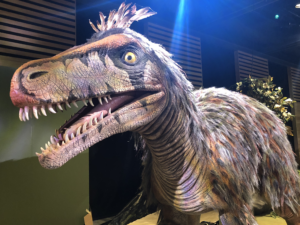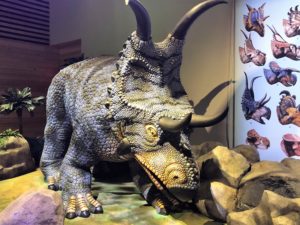When I recently took a 5-year-old to the Witte Museum, he learned that a major dinosaur exhibit was about to open for the summer. “I want to come back here tomorrow to see it,” he said assertively. When I explained that it was not opening until the end of May, he was bitterly disappointed.
His reaction is probably typical. Kids seem fascinated by dinosaurs and the Witte’s exhibit “Predators vs Prey: Dinosaurs on the Land Before Texas” will give them a wonderful opportunity to see and learn about these Mesozoic Era creatures that roamed around these parts millions of years ago.

Installed in the Mays Family Center and fabricated by Allen-based Billings Productions, each animatronic dinosaur is displayed in a setting that represents the natural environment of the period in which it lived. That part of the exhibit was made by Boerne-based SRO, a theatrical and event set design and construction company. Both companies worked with Dr. Thomas Adams, the Witte’s curator of paleontology and geology to ensure scientific and historical accuracy.
 “Everyone loves dinosaurs,” said Adams. “This exhibit is an opportunity to bring people in and educate them about these animals. We call this Texas Deep Time. Dinosaurs lived here – and elsewhere – 70 to 220 million years ago. Some of the fossils shown here are on display for the first time ever. Fossils are the way we learn about dinosaurs.”
“Everyone loves dinosaurs,” said Adams. “This exhibit is an opportunity to bring people in and educate them about these animals. We call this Texas Deep Time. Dinosaurs lived here – and elsewhere – 70 to 220 million years ago. Some of the fossils shown here are on display for the first time ever. Fossils are the way we learn about dinosaurs.”
The life-size creatures are equipped with electronic brains that control their movements and sounds. And, yes, they roar and move… well, in a limited but sometimes startling way. One little dinosaur surprised me by appearing to react to my approaching it. It moved its head and “looked” at me.
The mighty ones, like Tyrannosaurs Rex and the armored specimen Edmontonia, are as impressive as you can imagine, and there’s an active predator vs. prey installation showing Tenontosaurus fending off several Deinonychus.
Hands-on interactive devices help visitors see aspects of the animals’ behavior in motion.
Adams pointed out that visitors may be surprised to see several feathered dinos, which connects them directly to their evolutionary descendants, the birds.
In addition, real dinosaur fossils are displayed in cases, some with evidence of predatory attacks, such as teeth marks on bone.
Special public programs will be offered throughout the run of “Predators vs. Prey.” Check the museum’s website www.WitteMuseum.org. The exhibit will close September 3, to subsequently travel to other cities.





